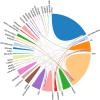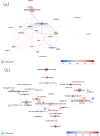Trends in enhanced recovery after surgery (ERAS) in thoracic surgery from a bibliometric insight
- PMID: 40660412
- PMCID: PMC12261781
- DOI: 10.1186/s41065-025-00501-9
Trends in enhanced recovery after surgery (ERAS) in thoracic surgery from a bibliometric insight
Abstract
Background: In thoracic surgery, the concept of Enhanced Recovery After Surgery (ERAS) has been extensively implemented. Although numerous studies have investigated ERAS in thoracic surgery, bibliometric analyses remain limited. In this study, the developmental trajectory, current research status, and prospective trends of ERAS in thoracic surgery were systematically analyzed through bibliometric and visual analysis techniques.
Methods: Literature pertaining to ERAS in thoracic surgery was retrieved from the Web of Science Core Collection (WoSCC). Microsoft Excel 2019, R software (version 4.1.0), the Bibliometric Online Analysis Platform, VOSviewer (version 1.6.18), and Citespace (version 6.3.R1) were utilized for statistical analysis, bibliometric evaluation, and data visualization.
Results: A total of 617 publications were retrieved over the past decade. The number of publications has generally demonstrated an upward trend from 2015 to 2024. China and Sichuan University ranked as the leading country and institution, respectively, in terms of publication volume. The Journal of Thoracic Disease was identified as the leading journal in both publication count and citation frequency. Henrik Kehlet was recognized as the most prolific and highly co-cited author. Current research hotspots include "video-assisted thoracic surgery," "pain management," and "multicenter clinical trials."
Conclusion: ERAS-related research in thoracic surgery has been increasing steadily, highlighting it as a rapidly evolving and promising field. The ERAS concept plays a critical role in all perioperative phases-preoperative, intraoperative, and postoperative-and requires further in-depth investigation. Many existing ERAS studies in thoracic surgery lack high-quality evidence, underscoring the urgent need for rigorously designed research with robust methodological standards.
Keywords: Bibliometric analysis; Citespace; ERAS; Enhanced recovery after surgery; Thoracic surgery; VOSviewer.
© 2025. The Author(s).
Conflict of interest statement
Declarations. Ethics approval and consent to participate: Not applicable. Consent for publication: Not applicable. Competing interests: The authors declare no competing interests.
Figures











References
-
- Kehlet H. Multimodal approach to control postoperative pathophysiology and rehabilitation. Br J Anaesth. 1997;78:606–17. 10.1093/bja/78.5.606. - PubMed
-
- Fearon KC, Ljungqvist O, Von Meyenfeldt M, Revhaug A, Dejong CH, Lassen K, et al. Enhanced recovery after surgery: a consensus review of clinical care for patients undergoing colonic resection. Clin Nutr. 2005;24:466–77. 10.1016/j.clnu.2005.02.002. - PubMed
-
- Ljungqvist O, de Boer HD, Balfour A, Fawcett WJ, Lobo DN, Nelson G, et al. Opportunities and challenges for the next phase of enhanced recovery after surgery: A review. JAMA Surg. 2021;156:775–84. 10.1001/jamasurg.2021.0586. - PubMed
-
- Bertolaccini L, Batirel H, Brunelli A, Gonzalez-Rivas D, Ismail M, Ucar A.M., et al. Uniportal video-assisted thoracic surgery lobectomy: a consensus report from the uniportal VATS interest group (UVIG) of the European society of thoracic surgeons (ESTS). Eur J cardio-thoracic Surgery: Official J Eur Association Cardio-thoracic Surg. 2019;56:224–9. 10.1093/ejcts/ezz133. - PubMed
-
- Batchelor TJP, Rasburn NJ, Abdelnour-Berchtold E, Brunelli A, Cerfolio RJ, Gonzalez M et al. Guidelines for enhanced recovery after lung surgery: recommendations of the Enhanced Recovery After Surgery (ERAS®) Society and the European Society of Thoracic Surgeons (ESTS). European journal of cardio-thoracic surgery: official journal of the European Association for Cardio-thoracic Surgery 55 (2019) 91–115. 10.1093/ejcts/ezy301 - PubMed
MeSH terms
LinkOut - more resources
Full Text Sources
Miscellaneous

